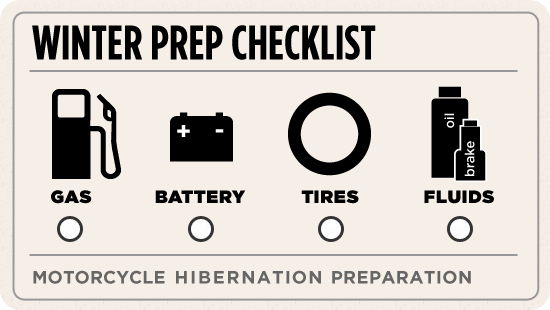Gonna put your bike away for the season? Then the very first thing to do is fire on down to the gas station and fill that baby up (right to the top mind you!). While at it, think about adding a fuel stabilizer (Sta-bil comes to mind. There are others.) Why a full tank? Simple. You are trying to minimize the air volume in the tank. Air contains moisture. Moisture can cause corrosion on the inside of your (steel) gas tank. `Nuff said. The purpose of the fuel stabilizer is to inhibit the fuel that will be sitting there all winter from becoming the goopy, sticky, varnishy stuff that is famous for clogging up ports, jets, and all those tiny orifices in fuel systems. If you have a carbureted bike, you would also be well-advised to shut off the fuel valve and then run the bike till it quits, leaving the float bowls empty for their long winter’s night. Another thing you might want to consider just after arriving home from the filling station is a quick oil change before you put your baby to sleep. Most riders know that oil both lubricates and cools your engine. Fewer know about your oil’s role as a place for nasty stuff like combustion gases and acids as well as particulate dirt and crap to collect. Stir up all that stuff with your short pre-hibernation ride, then drain it out while it’s still warm. Replace with fresh new oil and all the bad stuff goes away to the recycling center rather than falling out of suspension and ending up in the bottom of your crankcase.

Then there is the issue of batteries. Discharged and/or frozen batteries are definitely bad news. If the battery is allowed to discharge too far, sulfation of the plates can occur and this is the beginning of the end for your battery. The very best solution is to remove your battery to a warm location (basement?) and leave it connected to a battery maintainer like a Battery Tender, Optimate, or Battery Minder for the duration. These microprocessor-controlled devices actually do a great job keeping the battery fully charged, but not overcharged as can happen with a simple trickle charger. Some even have a conditioning mode that can further reduce the disabling accumulation of sulfur on the plates. If you don’t want to remove the battery from the bike, so that you can more easily go riding on that freakishly warm 70 degree day in January, then connect your tender/charger directly to the bike; be careful with some modern bikes that have CAN bus controls integrated with the charging system (can you spell B-M-W?). Some of these bikes may require special charging hardware or routines. Check your owner’s manual.
Let’s not forget your tires. First of all, make sure the pressures are set to the recommended values or even a bit higher. Then, if possible, get the load off the tires. Sitting in one spot for the winter can leave you with flat spots that can sometimes take quite a few miles to work out. If you have a center stand, by all means put the bike up on it. If you have both front and rear stands, like a Pit Bull, then use those. If you can’t get the bike up in the air, you may want to consider pushing it around periodically to reduce the risk of flat spotting.
Then, if you really want to prep your bike for the off-season, I’d recommend the fall as a great time to do a brake fluid change. Brake fluid is this amazing liquid that works so well because it’s both incompressible and resistant to heat. It does have, however, this one tiny little undesirable characteristic. It likes to absorb moisture. Left to sit over several months, any absorbed water will end in the lowest parts of the system and will be the start point for corrosive activity in those pretty Brembo Calipers.
You’ll find that other operations, like a coolant change, are often recommended but let’s just call it good here. Spring will come soon enough, and if you just take care of these few items, you’ll be ready to go when the time comes. Unless, of course, you neatly avoid all the nuisance by becoming a year-round rider. Join us. It’s fun!
-Jack Broomall
Jack Broomall is a lifelong motorcyclist. His motorcycle adventures have taken him across the North American continent several times, to Alaska, the Alps, the United Kingdom and the Isle of Man. He is a member of the Iron Butt Association and also owns several motorcycle Land Speed Records set at the Bonneville Salt Flats where he is a member of the Bonneville 200 MPH Club. He has been known to do occasional restorations of his favorite bikes from the 1970s and enjoys track days as well.

No comments:
Post a Comment